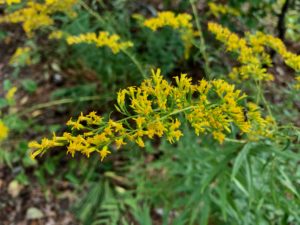
by Mary Reid Barrow
Fall is on its way and do you know how I can tell? It has nothing to do with the weather or the temperature, or the calendar, even though the calendar right in front of me says autumn arrives Tuesday.
It’s none of those. It’s the goldenrod which has been growing taller and taller throughout the summer along with other road and trail side plants and weeds that you never give a second thought, even a first thought to..
Then suddenly with no warning or fanfare, the tops of this inconspicuous plants, begin to color up. And you realize all along what you are seeing is goldenrod preparing for its late season burst of dazzling yellow.
At first the sprays are small and pale and as fall approaches, the sprays get bigger and brighter and brighter as if they are building to a crescendo to greet the season.
I am sure some of you sneeze at just hearing the word goldenrod and are dismayed to hear of its arrival because the plant is a real scapegoat for late season allergies.
But it’s time to give this harbinger of fall a break. Goldenrod is not the cause of autumn hayfever. The culprit is a plant called ragweed. Small and non- descript, it, too, blooms and grows alongside goldenrod in old fields and on roadsides.
Ragweed is pollinated by the wind and its pollen blows hither and yon and right to your nose. Goldenrod, on the other hand, is pollinated by insects that carry the pollen from bloom to bloom.
According to “Native Plants for Southeast Virginia, including Hampton Roads Region,” goldenrod also supports 112 caterpillars, the greatest number of caterpillars of any of our native wildflowers.
That means goldenrod is one of our top native plants, especially , because it blooms in fall and is a food source after many other plants have stopped blooming. Goldenrod provides more pollinators for our gardens and more food for birds, particularly youngsters who dine on soft-bodied insects.
Goldenrod species, several of which are natives here, are in the genus Solidago. Solidago comes from the Latin, “to make whole,” because goldenrod was once used to heal wounds, certainly not to cause allergies.
To find out more about which species you can grow in your yard, check the native plant guide online: https://www.deq.virginia.gov/Portals/0/DEQ/CoastalZoneManagement/Native-Plants-for-Southeast-Virginia-Guide.pdf
Plant some for the insects and the birds and to welcome autumn t0 your yard and, as I said, give goldenrod a break!
P.S. What are your favorite signs of fall ? Let me know. For example, just the other day, the Virginia Native Plant Society posted a photo of a bright red leaf from a black gum tree, saying the black gum was one of the “earliest of our native trees to exhibit bright fall color. “ Look for black gums around the cypress ponds in First Landing State Park.
Do you have a favorite tree or plant with a story to tell? What relationships have you observed between plants and critters? Who eats whom?